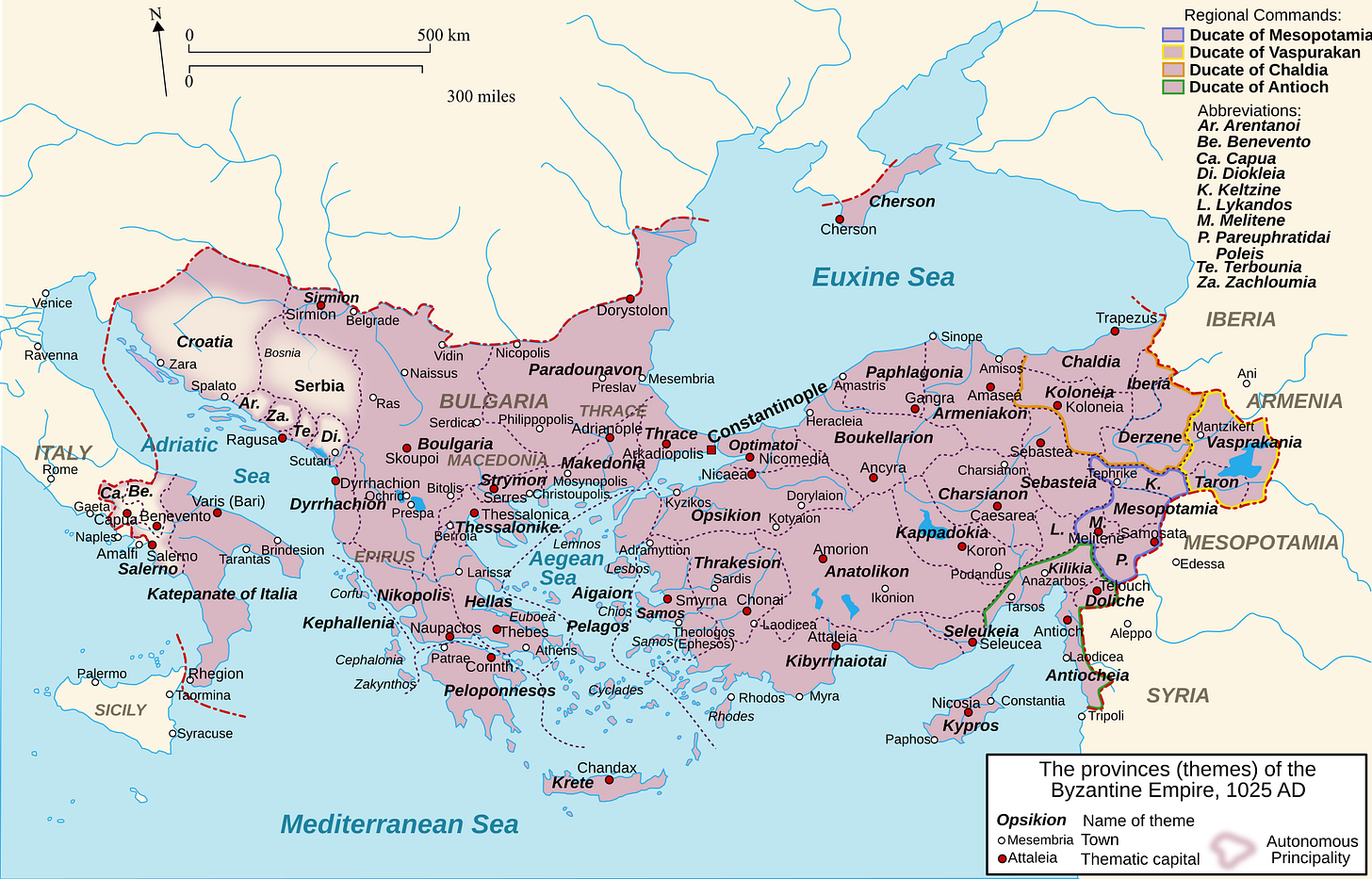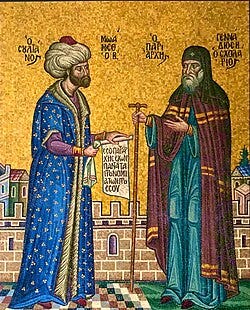The second civilisation that emerged from the ruins of the Roman Empire was the Rhomaic civilisation. By the term Rhomaic here I mean the inhabitants of the Greek-speaking Eastern Roman Empire with its capital at Constantinople who referred to themselves as Rhomaioi and their country as Rhomania. In the words of historian Anthony Kaldellis, " It is well known that the people we call Byzantines today called themselves Romans (Romaioi). In the middle period of Byzantium's history...this "national" label appears or is pervasive in virtually all texts and documents (excluding the strictly theological) regardless of the geographical or social origins of their authors, which, in Byzantium, were diverse. ("Byzantines" were for them only the residents of Constantinople, archaically styled after the City's classical name.) These Romans called their state Romania or Romaïs, its capital New Rome (among other names, titles, and epithets), and its rulers the basileis of the Romans, whom we call "emperors"...1
The Persians called them Hróm, the Arabs Rúm, and the Turks so called their sultanate in Anatolia on territories they conquered from the Rhomaic Empire . And when their Ottoman descendants crossed the Sea of Marmara, they called the Balkan lands Rumelia, (Rum eli) or the land of the Romans.
By rejecting the Byzantine appellation in this chapter, we also reject the myth of a discontinuity that did not occur here. In the reign of the Emperor Justinian, the Roman Reconquista of the western provinces was quite realistically contemplated; the emperor himself came from among the Romanised Balkan provincials. The cataclysmic war against Sassanian Iran exhausted the forces of both oriental powers, and both empires found themselves effectively defenceless against the Arab outbursts, which in short sequence conquered the Levant, Egypt and (North) Africa, before defeating the Visigothic kingdom in Hispania.
The Rhomaic Empire retreated behind the Taurus Mountains and to a few safe coastal strongholds in the Balkans after the expansion of the Slavs - its centre of gravity was now in Anatolia. The empire lost its cosmopolitan character and the Greek language became one of the mainstays of identity alongside the Orthodox religion. In the epoch between the 7th and 11th centuries, life returned to the countryside. Through the various themata, decision-making was delegated to the regions. The primary axis of this civilization connected Constantinople with the Taurus Mountains towards Antioch. On the European side of the Sea of Marmara, this axis continued further, through Adrianople (bulgaricé Odrin), Plovdiv, Sofia, Niš to Belgrade. The secondary, geopolitical axis of this civilization followed the contours of the ancient Via Egnatia: from Constantinople along the Thracian coast to Thessalonica,, Ohrid, and Dyrrhacium, and thence across the sea to Apulia, Taranto, and Naples; and in an easterly direction along the Pontic coast to Georgia and to the Alans beyond the Caucasus.

Medieval Rhomania conquered the Serbian and Bulgarian lands, which it incorporated directly into its cultural as well as its political sphere. In the east, Georgians, Circassians and Alans, ancestors of today's Ossetians, became part of the Rhomaic civilisation.
Apart from these peoples, the Rhomaic civilisation has also managed to spread to the peripheries: among the Vlachs, ancestors of later-day Romanians, and among the southern Albanians, though both Albania and Bosnia became a region of twilight, missionary territory of competition for prelates from both the Rome on the Tiber and the Rome on the Bosporus.
Was Toynbee correct and the cataclysmic war of the Rhomaic civilisation was the campaign of Basil II. against Bulgaria, which ended with the annexation of that South Slavic empire? Did the universal empire of this civilization become the Ottoman Empire, as Toynbee sees it, or the empire under the Macedonian dynasty at the height of its glory, before it itself experienced its fatal defeat on the battlefield of Mantzikert?
This civilisation too, can lay claim to the triple inheritance of Rome, Athens and Jerusalem. Rome here has been preserved in the appelation and in the continuity of the state and imperial office, though the title has shifted from the early Princeps and later Dominus to the Basileus and Autokrator. Constantinople, the capital of the Empire was the New Rome. The legacy of Athens had been preserved in the Rhomaic civilisation well by virtue of the philosophical writings being preserved in the original Greek rather than being forgotten and rediscovered by translation from Arabic. True to this were the fierce theological-philosophical debates that rather often tore the Empire asunder. And thirdly, the legacy of Jerusalem has been preserved in the form of the Orthodox Church that preserved the True Faith as understood in Constantinople. As such the Rhomaic civilisation was a much more direct successor to the civilisation of Classical Antiquity than the Frankish civilisation. Unlike the Frankish civilisation, the Rhomaic civilisation developed quite a different understanding of the relations between Church and State.
Having crystalised in the bastion of the Anatolian peninsula and the few coastal cities of the Balkans, the Rhomaic civilisation hence spread northwestwards to meet the Frankish civilisation along the Sava River and Carpathians (though having a slight influence on the Intermarium through the Cyrillo-Methodic mission), southwestward towards the Mezzogiorno, southeastwards into Cyprus and among the Antiochian Greeks and norteastwards into Georgia, Circassia and Alania.

To what extent did the Ottomans become bearers of this civilisation? Some of their sultans tried to embrace the Rhomaic legacy by styling themselves kayser-i Rûm (Emperor of the Romans) . The architectural and geopolitical legacy remained constant - both empires having their capital on the Bosporus at the place where the Balkans and Anatolia meet. The Ottomans have managed to solve the issue that cost the Rhomaic Empire the loyalty of its southern provinces by establishing the millet system allowing communal autonomy for Orthodox, Armenian and Jewish subjects, recognising the fact of religious pluralism.
And yet at the core, it appears that the Ottomans had perhaps become overlords of one civilisation, yet they were torch-bearers of another. Indeed they shared kinship with the peoples of Persia and Transoxiana as members of a Khorasanian or Turko-Persian civilisation, as evidence in their high literary language, which was neither Arabic nor Greek. The civilisational difference also explains the fierce hostility which was encountered by the Ottoman garrisons in the Balkan Wars.
KALDELLIS, Anthony: Hellenism in Byzantium




